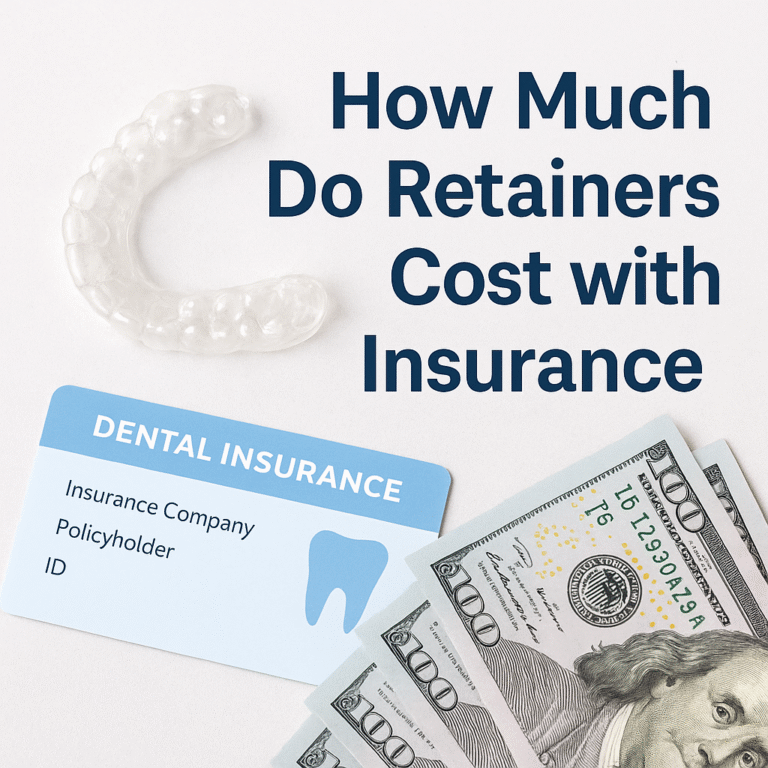Getting a retainer after orthodontic treatment is a crucial step to maintain your beautiful smile. But many people wonder, how much do retainers cost with insurance? The answer depends on your insurance plan, the type of retainer, and your provider. In this expert-backed guide, we’ll walk you through everything you need to know in simple, clear language.
Understanding Retainers and Dental Insurance
Retainers help keep your teeth in place after braces or Invisalign. They come in different types: Hawley, Essix (clear plastic), and permanent (bonded). These are vital in maintaining your new smile.
Dental insurance can lower the cost of retainers—but not all plans cover them. Some cover part of the cost, some don’t. Knowing your benefits is the first step.
Average Cost of Retainers Without Insurance
Without insurance, retainer prices can surprise you. Here’s a breakdown of average prices:
- Hawley Retainer: $150 to $300 per arch
- Essix (Clear) Retainer: $100 to $250 per arch
- Permanent Retainer: $200 to $500 per arch
Prices vary by provider, region, and replacement needs. If you lose or damage your retainer, you may pay again. That’s where insurance can help.
How Much Do Retainers Cost With Insurance?
With insurance, the cost of retainers can drop significantly. Some plans cover 20% to 50%, while others include retainers in overall orthodontic coverage. You might only pay $50 to $150 out-of-pocket.
Many dental plans treat retainers as a follow-up to braces. If your braces were covered, your retainer likely is too—but double-check. Ask your insurer if your plan includes post-orthodontic appliances.
What Dental Insurance Covers Retainers?
Several top providers offer plans that may cover retainers:
- Delta Dental: Some plans offer 50% coverage for retainers
- Cigna: Includes retainers under orthodontic benefits
- MetLife: Covers retainers if braces were covered
Each policy is different. Some only cover one retainer or don’t cover replacements. Always review your Summary of Benefits.
Factors That Influence Retainer Costs
Costs vary due to:
- Type of Retainer (clear, metal, or permanent)
- Provider Fees (specialists may charge more)
- Geographic Location (urban vs. rural costs)
- Replacement Costs (lost or broken retainers)
Even with insurance, you may need to pay part of these costs. But staying in-network can help you save more.
Comparing Different Types of Retainers and Their Costs
Each type of retainer has pros, cons, and cost impacts:
- Hawley Retainer: Durable and adjustable, lasts years, around $200 per arch.
- Essix Retainer: Invisible and comfortable, needs replacement every 1-2 years, $150 average.
- Permanent Retainer: Bonded behind teeth, no removal needed, but costlier upfront at $300+.
Choosing the right one depends on your lifestyle and budget. Talk to your orthodontist for advice.
Is a Retainer Covered If You Lost It?
Sometimes. Some insurance plans cover one replacement every few years. Others don’t cover replacements at all. Losing your retainer may mean full out-of-pocket cost.
Ask your provider: Does your plan cover retainer replacement? Does it count toward your annual max? These details matter.
How to Check if Your Insurance Covers Retainers
Here are 3 quick steps:
- Log in to your insurer’s online portal and check orthodontic benefits.
- Call your provider and ask specifically about retainer coverage.
- Ask your dentist or orthodontist to verify coverage before treatment.
Also, review your EOB (Explanation of Benefits) after any orthodontic treatment. It will show what was paid and what’s left for you.
Tips to Lower Retainer Costs With or Without Insurance
- Use HSA or FSA: These pre-tax accounts can cover retainer costs.
- Dental Discount Plans: Offer 10%-60% savings if insurance doesn’t apply.
- Shop Around: Different providers have different prices.
- Orthodontic Schools: Provide affordable treatment by students supervised by licensed professionals.
- Bundle Appointments: Some offer discounts for paying upfront.
Alternatives If Your Insurance Doesn’t Cover Retainers
No coverage? Don’t worry. Try these smart alternatives:
- Membership Programs: Many dental offices offer savings plans.
- Payment Plans: Monthly installments make retainers more affordable.
- Nonprofit Clinics: Offer care on a sliding scale.
- Orthodontic Schools: As mentioned earlier, they’re budget-friendly.
These options help protect your investment in your smile—without breaking the bank.
Final Thoughts: Making Retainers Affordable with the Right Insurance
Retainers are essential. With the right insurance, you can save hundreds. Even if your plan doesn’t cover everything, using FSAs, shopping smart, and exploring options can reduce your costs.
Choosing the right provider, verifying benefits, and asking questions will empower you. Your smile deserves that care.
And remember: insurance matters in many areas. Like knowing how long does reckless driving affect insurance or asking do car dealerships offer temporary insurance, being informed helps you save.
FAQs About How Much Do Retainers Cost with Insurance
Are retainers usually covered by dental insurance?
Some dental insurance plans cover retainers, especially if they are part of orthodontic treatment. Coverage can range from partial to full depending on your provider and policy.
What is the average cost of a retainer after insurance?
After insurance, most people pay between $50 and $150 per arch, depending on their plan, type of retainer, and provider network.
Which dental plans include retainer coverage?
Plans from Delta Dental, Cigna, and MetLife often include retainer coverage as part of orthodontic benefits. Always check your specific policy.
Can you use HSA or FSA to pay for retainers?
Yes! Health Savings Accounts (HSA) and Flexible Spending Accounts (FSA) can be used to pay for retainers if they are prescribed by a dentist or orthodontist.
How much does it cost to replace a lost retainer with insurance?
If covered, replacement costs can be $50 to $150. But not all plans include replacements. Without coverage, costs may rise to $300 or more.
